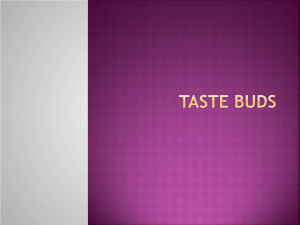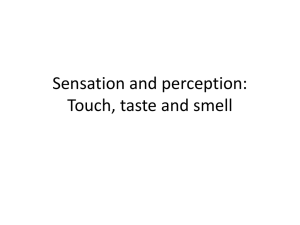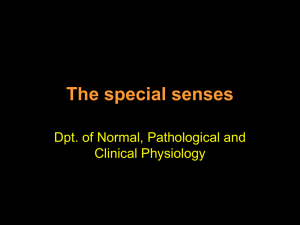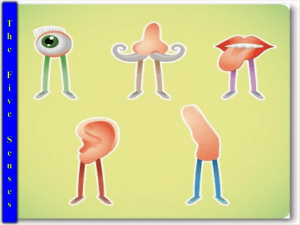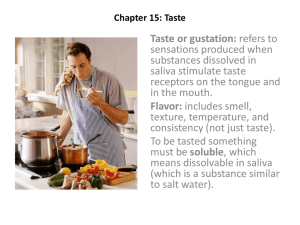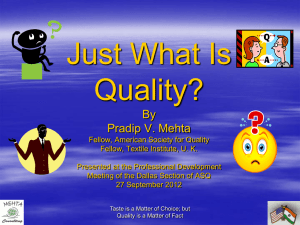Roundtable Karen Rodriguez Teaching Taste ppt
advertisement
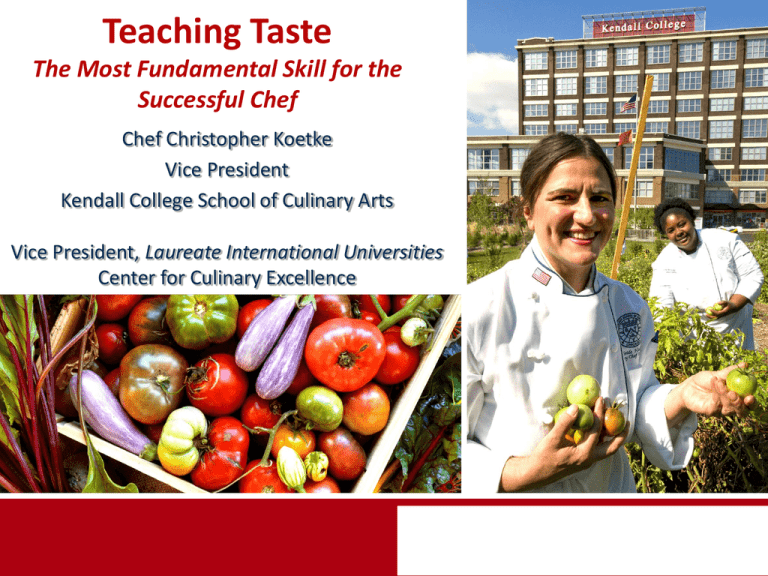
Teaching Taste The Most Fundamental Skill for the Successful Chef Chef Christopher Koetke Vice President Kendall College School of Culinary Arts Vice President, Laureate International Universities Center for Culinary Excellence chris.koetke@kendall.edu My Taste Teaching Journey • As a chef: – Expert in the kitchen – Problem solver – Got students to perform well per my instructions – Great teacher? But what is the highest goal of education? Critical thinking, problem solving, empowered, self critical/QA Do Our Students Taste? • How we train our children – Johnny – Jean • And voila—what should we expect? The Role of Taste • Interpretation of food as: – Safe to eat – Nutritional needs – Define who you are – Delicious to eat--pleasure • Quality control I don’t want to eat it. I don’t care… and the orchestra Taste 101: Visual • • • • • – – – Precursor to the chemical /physical appreciation Is it safe to eat? Do I want to eat it? Consider color, height, shape Color and shape ex. Open kitchens Action stations Tableside service Taste 101: Visual • • • • – – Deceiving the customer for fun All that is new is really old Enter molecular gastronomy The caution of over emphasizing appearance Colored water and Champagne in brown bags White and little shape exersize Taste 101: Hearing • • • • • Can you really hear food? Bubbles Crunch Sizzle Kitchen sounds Taste 101: Olfaction • First chemical interpretation of food – – • Two pathways – – • Is it safe to eat? Do I want to eat it? Nasal Retronasal Alert system Taste 101: Olfactory “Taste” • • • • • • • • 20,000 aromas Many levels of intensity Some very small Complexity Memory Nostril differences Social training Thermal role Taste 101: Taste • • • • • Final Chemical Analysis of food 5 tastes: sweet, salt, acid, bitter, umami The tongue map—taste buds in the mouth Super tasters: 25% population (2/3 women) Importance of finish Why Do We Have Tastes? Where do we learn these? History of Umami Rome Thailand So, why don’t I recognize umami like other tastes if it is so essential? Could it be social training? What is Umami? • Start with definitions—protein 101 – Glutamic acid = amino acid (protein) – Free glutamic acid/glutamate = one which is not bound to anything else – Umami = taste sensation derived from free glutamic acid bound to a salt, most notably (and deliciously) sodium – Found in a wide variety of foods and MSG Where Are Glutamates? • • • • • Ripening Maturation Curing Cooking Adding glutamate or glutamate-rich stock Is MSG Safe? The body makes no distinction • 1958 US FDA—Generally Recognized as Safe (GRAS) • 1987 Joint Expert Committee on Food Additives (JECFA) of UN Food and Agriculture Association confirmed MSG is safe • 1991 European’s Commission’s Scientific Committee for Food decided unnecessary to set Acceptable Daily Intake level (ADI) • 1995 US FDA Federation of American Societies for Experimental Biology (FASEB) confirmed safety as food ingredient Taste 101: Texture • • Mouth “feel” Thermal – – • • • Bubbles Soup (hot/cold) Particulate Slimy, fatty, sticky, etc. Spicy/aggressive Taste 101: Other factors • • • • • • • History and associations Social groups Religion Individual perceptions/history Individual biological differences The story Opinions of others/marketing Teaching Taste • Assessing our assumptions – – – – Assume the students can’t recognize taste Assume they have no taste library Assume that they have no words for taste Learn about our own taste, preferences, and preconceived ideas Teaching Taste • Objective: – – – – – Build skills Build tasting library Build vocabulary (not with a list) Build an impulse to taste Build a control Teaching Taste • The basics: – – – – – Ask lots of questions, prod and struggle Assign words and categorize them Make students write down words Have fun! Disarm them Make sure everyone contributes Teaching Taste • Organized tastings: – – – – Up and down tasting and perfection Redefine a familiar definition/experience Comparative tastings (start very diverse) Single tastings (start with familiar, build on library experiences) Teaching Taste • Non-organized tastings: – – – – – – – Reinforce tastings through curriculum Take every chance to build library Do not give answers! Use the individual experience to teach the group Use extremes (what is acid? Maillard reaction) Use comparative tastings—i.e. the sauce Balance Teaching Taste • TAAT: – Taste – Analyze – Adjust – Taste T A A T So, is taste the most important kitchen skill after sanitation? Now, Let’s Taste • • • • • What is crunchy Chocolate comparative tasting Honey and sugar What is chewy Potato chips THANK YOU Teaching Taste The Most Fundamental Skill for the Successful Chef Chef Christopher Koetke CEC CCE HAAC chris.koetke@kendall.edu
